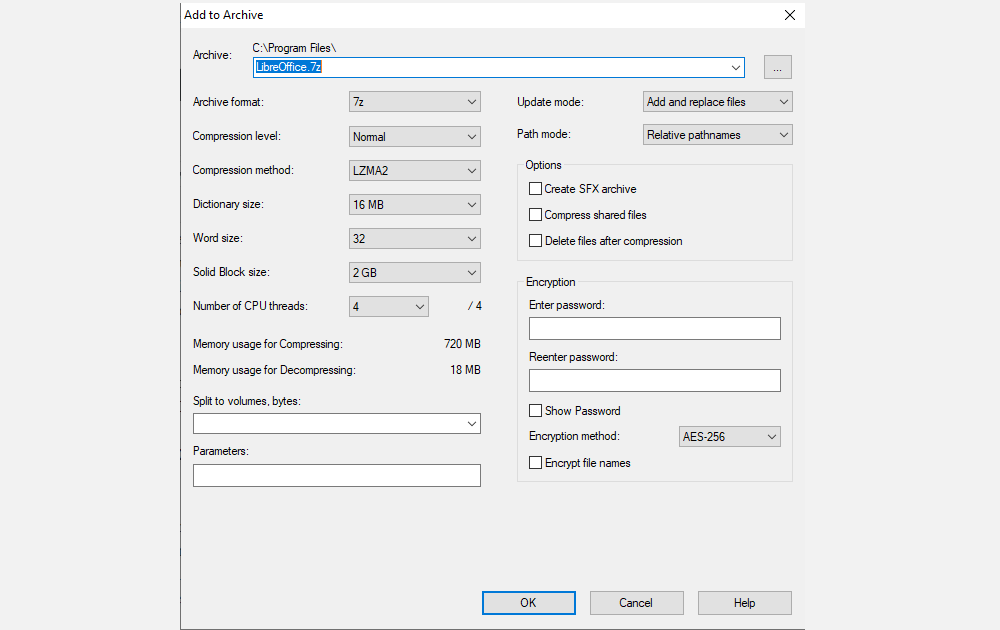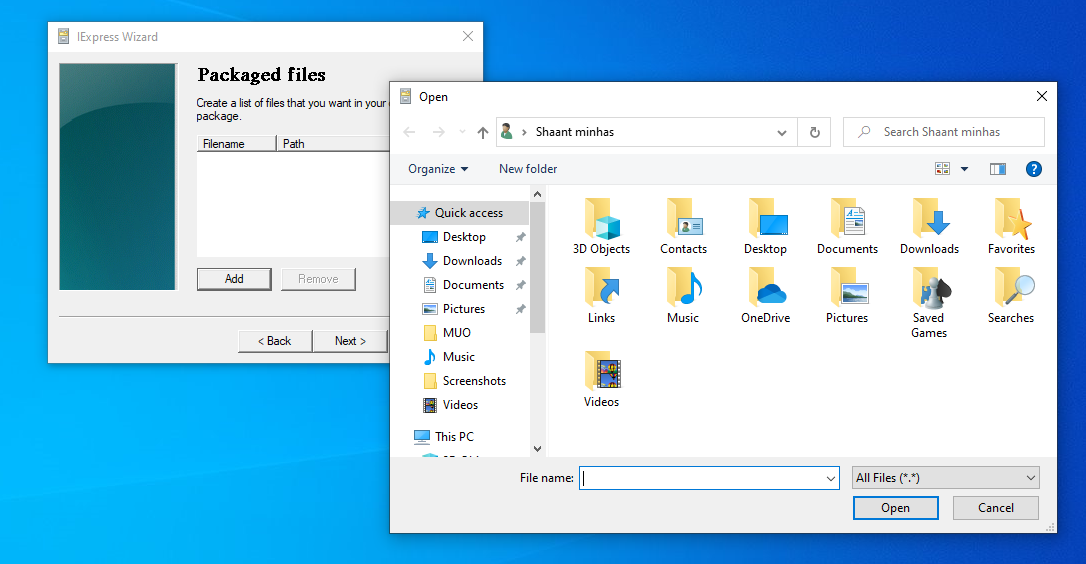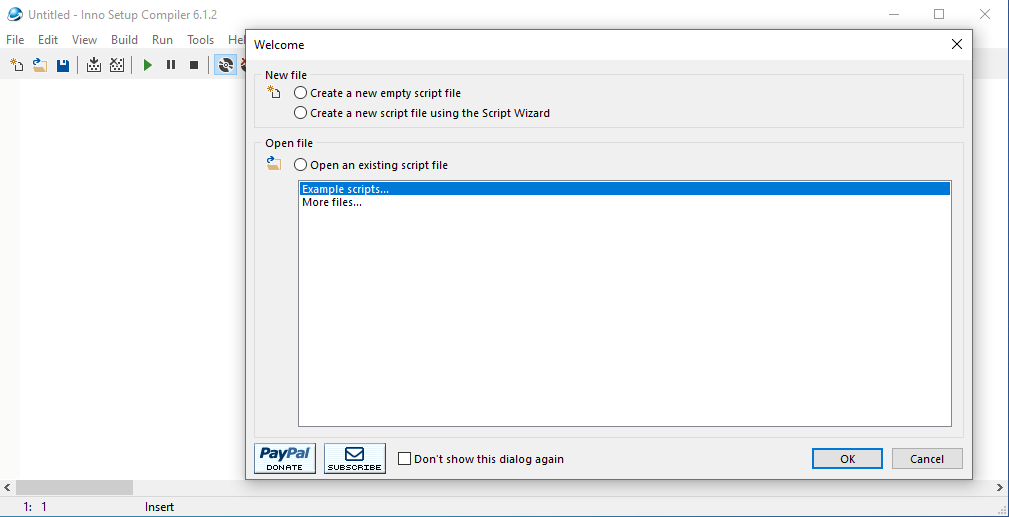How To Make An Installer Exe
What do you exercise when y'all've created some new Windows software—anything from a simple diagnostic tool to a complex PC video game—and you lot want to share it with the globe? Well, you could compress the files into a single Nil file and distribute that.
Or, you can be fancy and create an installer EXE instead.
We'll be roofing three different ways to make an EXE in this mail: a self-extracting package, a uncomplicated installer using the congenital-in IExpress, and an avant-garde installer using the customizable Inno Setup.
i. Make a Quick EXE File Using 7-Nix
Yous probably already employ 7-Zip to excerpt all kinds of archive files and know that 7-Nix can create annal files, but did you know that you can too apply information technology to create an EXE file that acts as an installer?
Information technology'due south called an SFX annal (self-extracting) and works past compressing all of your end files together, then embedding a special EXE file within the archive that knows how to extract everything.
In other words, the recipient tin extract the SFX archive (which appears every bit an EXE file itself), even if they don't have the correct software, which can happen with formats like 7Z, RAR, TAR, and ZIP.

Here's how to create an SFX archive with 7-Zip:
- Set all of your files and directories within a single principal directory and name the directory whatsoever you wish.
- Correct-click on the directory and select 7-Nil > Add to archive...
- Under Options, enable Create SFX Archiveand select the following settings...> Archive Format:7z> Compression Level:Normal> Compression Method: LZMA2> Dictionary Size: xvi MB> Word Size: 32> Solid Block Size: ii GB
- Finally, click onOK.
Note that SFX archives aren't truthful installer files. They don't identify the extracted files into a designated target directory. They don't modify Windows Registry. Furthermore, they don't create install logs, and they don't show up as installed software in the Uninstall app. They are literally annal files dressed up as EXE files.
Download: 7-Zilch for Windows (Free)
ii. How to Use IExpress to Make an EXE Easily
IExpress is a utility that comes bundled with versions of Windows starting with Windows XP and across. The utility comes with a front-end graphical interface (called IExpress Wizard), but you tin can also create installer files using paw-scripted Self Extraction Directive (SED) files. We recommend the Magician.
Similar 7-Nix above, this method creates a self-extracting archive, only with two major differences: one, the end-user volition proceed through a multi-folio Installation Wizard, and two, the end-user tin specify the target directory to where the tool will extract the files.
And this how you create your installer EXE using IExpress:
- Open the Run prompt (Windows key + R) and blazon iexpress.exe to launch the IExpress Wizard.
- Select Create new Cocky Extraction Directive file and click Side by side.
- Select Extract files merely and click Adjacent.
- For the package title, the proper noun of your app is a safe pick.
- For the confirmation prompt, cull No prompt or Prompt user with. It doesn't thing either mode. For the end-user, including one is ever a safe choice.
- For the license agreement, selectDisplay a license if you desire the end-user to concur to an End User License Agreement (EULA). If non, it's fine to select Do non display a license.
- Add together all the files yous want to come across installed by clicking Add, browsing to where the files are, and selecting them all.
- Continue through the IExpress Sorcerer and select your preferred options for the Show Window and Finished Message prompts.
- For the parcel name, click Browse, navigate to where you want the installer EXE to be created, and give information technology a proper noun. This is the EXE file that y'all are going to distribute to cease-users. Click Adjacent.
- Finally, select Salve Self Extraction Directive (SED) file if yous desire to create a modified installer subsequently on, such as when you lot've patched the software and demand an updated installer. If you select Don't save, then you'll have to run through the entire process from scratch.
- On the Create Package page, click Side by side.

Your bundle volition be created in a few minutes. Note that IExpress has some quirks and problems :
- Information technology doesn't let the inclusion of empty directories.
- If your installation has subdirectories, the subdirectories won't be included.
- If you take multiple files of the aforementioned name, even within separate directories, the installer cosmos volition fail.
Considering of these oddities, nosotros recommend using the method beneath instead.
3. The Best Way to Make an EXE: Use Inno Setup
Inno Setup is an open-source utility that'southward been in agile development since 1997. It was created partly in response to the at-the-fourth dimension subpar InstallShield Express. Since and then, it has become the installer creator of selection for those who don't care to explore proprietary options.
Its biggest describe is its flexibility. Inno Setup uses script files with an ISS extension ("Inno Setup Script") to customize various aspects of the installer: which files are incorporated, where the installation happens, whether to create shortcuts, etc. ISS files use similar formatting to INI files and tin can be generated using the Inno Setup Wizard.
To create your installer using Inno Setup, launch the Inno Setup Compiler app. In the welcome prompt, select Create a new script file using the Script Wizard. From there, enter your Awarding Proper name and Application Version. Optionally, you lot can likewise include Application Publisher and Awarding Website details. Click Next.

- Now, select the Destination base folder, which defaults to Program Files.
- Enter an Application folder name, which is the name of the principal directory where your installation files will go. Click Next.
- For theApplication main executable file, browse and select the chief EXE file that volition launch your app.
- If you aren't installing an app, enable The application doesn't have a main executable file. Then add files and folders to your installation with the Add files... and Add folders... buttons. Click Side by side.
- On the Application Shortcuts page, get out the defaults or modify them to fit your preferences. They're all self-explanatory. Click Next.
- On the Awarding Documentation page, y'all tin point to up to iii TXT files that will display throughout the end user'due south installation procedure. Typically, these will be LICENSE.TXT, INSTALL.TXT, and README.TXT, merely they tin be any you want. Click Next.
- On the Setup Languages folio, continue English, just you are welcome to add as many other languages every bit you lot wish. Click Next.
Now, follow these steps from beneath:
On the Compiler Settings page, you can customize the installer EXE file:
- The Custom compiler output binder is where the resulting installer EXE file will be placed.
- Compiler output base file name is what the EXE file will be chosen. The default setting is setup.exe.
- Custom Setup icon file is the icon the installer EXE file volition utilize. This must be an ICO file, which you can download or converted from PNG.
- Setup password will protect unauthorized users from using your installer. Exit information technology blank to disable this feature.
Subsequently configuring your settings, selectCease. When prompted to compile the new script, click Yes. When prompted to save the script, select No if this is a ane-time installer file. Select Yep if you plan to modify or update information technology later.
Look for the process to get completed, and voilà, you'll have an executable file with you.
Download: Inno Setup for Windows (Free)
Which Method Is All-time for Creating EXE Installer?
If your software is basic, or if you're only going to distribute to a limited number of people, go with the 7-Zip method. Information technology'southward piece of cake, fast, and requires about no technical expertise.
If your software is somewhat simple, and yous desire to present a real installation wizard for your end-users, go with the IExpress method. Finally, opt for the Inno app if you lot have complex software and you know what you are doing.
About The Writer
Source: https://www.makeuseof.com/tag/how-to-make-an-exe-installation-file/
Posted by: sullivantruch1988.blogspot.com



0 Response to "How To Make An Installer Exe"
Post a Comment